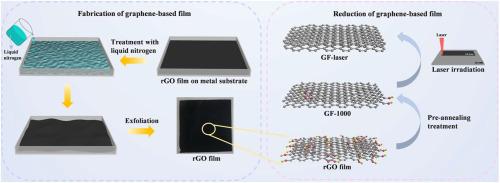Superior thermal conductivity graphene films achieved by laser-irradiation-treatment
IF 11.6
2区 材料科学
Q1 CHEMISTRY, PHYSICAL
引用次数: 0
Abstract
Graphene films (GFs) exhibit exceptional thermal conductivity, making them highly promising for thermal management applications by efficiently dissipating heat and ensuring the stable operation of electronic devices. However, their widespread adoption is hindered by complex preparation processes, particularly due to the ultra-high temperature annealing treatments. To address this challenge, this work presents an energy-saving and simple-to-operate preparation strategy of GFs. The fabrication process involves the synchronous reduction and assembly of graphene oxide (GO) on metal substrates, followed by a two-step treatment consisting of 1000 °C annealing treatment and laser-irradiation treatment to remove the oxygen-containing functional groups and repair the structural defects in the film. By substituting traditional ultra-high temperature treatment with laser irradiation, this approach significantly reduces the energy consumption and fabrication time, and the resulting GFs, after mechanical pressing, achieve an in-plane thermal conductivity of 1801.07 W m−1 K−1, surpassing that of conventional metal such as copper and aluminum. Therefore, our approach provides a superior thermal management solution for next-generation high-power electronics.

通过激光照射处理获得优越的导热性石墨烯薄膜
石墨烯薄膜(GFs)具有优异的导热性,通过有效散热和确保电子设备的稳定运行,使其在热管理应用中具有很大的前景。然而,它们的广泛采用受到复杂的制备工艺的阻碍,特别是由于超高温退火处理。为了应对这一挑战,本工作提出了一种节能且操作简单的GFs制备策略。制备过程包括在金属衬底上同步还原和组装氧化石墨烯(GO),然后进行两步处理,包括1000°C退火处理和激光辐照处理,以去除含氧官能团并修复薄膜中的结构缺陷。该方法通过激光照射取代传统的超高温处理,显著降低了能耗和制造时间,并且经过机械压制后得到的GFs的面内导热系数为1801.07 W m−1 K−1,超过了铜和铝等传统金属。因此,我们的方法为下一代大功率电子产品提供了卓越的热管理解决方案。
本文章由计算机程序翻译,如有差异,请以英文原文为准。
求助全文
约1分钟内获得全文
求助全文
来源期刊

Carbon
工程技术-材料科学:综合
CiteScore
20.80
自引率
7.30%
发文量
0
审稿时长
23 days
期刊介绍:
The journal Carbon is an international multidisciplinary forum for communicating scientific advances in the field of carbon materials. It reports new findings related to the formation, structure, properties, behaviors, and technological applications of carbons. Carbons are a broad class of ordered or disordered solid phases composed primarily of elemental carbon, including but not limited to carbon black, carbon fibers and filaments, carbon nanotubes, diamond and diamond-like carbon, fullerenes, glassy carbon, graphite, graphene, graphene-oxide, porous carbons, pyrolytic carbon, and other sp2 and non-sp2 hybridized carbon systems. Carbon is the companion title to the open access journal Carbon Trends. Relevant application areas for carbon materials include biology and medicine, catalysis, electronic, optoelectronic, spintronic, high-frequency, and photonic devices, energy storage and conversion systems, environmental applications and water treatment, smart materials and systems, and structural and thermal applications.
 求助内容:
求助内容: 应助结果提醒方式:
应助结果提醒方式:


